How to Connect and Sync ClickUp to Microsoft Excel With Automated 2-Way Updates
Getting ClickUp data into Excel can sometimes be a hassle, particularly if you’re copy-pasting individual details out of fields and into a spreadsheet. Yes, you can manually export CSV files, but going back and forth to maintain a source of truth is time-consuming, particularly if you’re managing hundreds or thousands of tasks. This guide will walk you through the process of syncing ClickUp tasks to a spreadsheet in Microsoft Excel with automated 2-way updates.
Exporting ClickUp projects to Excel rows with Unito is as easy as using any new app or platform – no coding knowledge required. Once you set up the workflow outlined in this article, you’ll have a simple no-code integration that turns newly created ClickUp tasks (or historical tasks) into Excel rows.
If you’d like to learn more about Unito first, check out our integration overview for Microsoft Excel and ClickUp.
Watch Unito’s 2-way ClickUp Excel integration in action:
By the end of this guide, you’ll be able to:
- Export ClickUp project data from tasks to Excel rows automatically.
- Generate new Excel rows automatically as your team creates ClickUp tasks.
- Update Excel in real-time with a 2-way sync whenever you make changes in ClickUp tasks, or vice versa.
In this article
- Step 1. Set up a table header in Excel
- Step 2. Install the Unito add-in for Excel
- Step 3. Connect ClickUp and Excel to Unito
- Step 4. Set a flow direction between ClickUp and Excel
- Step 5. Set up rules to filter data between ClickUp and Excel
- Step 6. Pair fields between ClickUp and Excel
- Step 7. Launch your ClickUp – Excel integration
- Best practices and troubleshooting
Before you connect ClickUp and Excel to Unito:
- Permissions required to sync: You must have read & write permissions in Excel, and your ClickUp account needs to be a full member of your organization, not a guest.
- Excel Add-in: Install the Unito add-in for Microsoft Excel Online. Without the add-in, you won’t be able to sync data between ClickUp and Excel.
- Table header: Set up a table header in Microsoft Excel so that the first row includes the names of your ClickUp task fields (e.g., title, description, assignee, etc.). More on this below.
If you aren’t sure where to begin, we created this template for Microsoft Excel users you can use to get started. Just be sure to download the template and then upload it to your own One Drive in order to use it.
Step 1. Set up a table header in Excel
Unito syncs fields in ClickUp to rows in Excel based on the header row.
So be sure to give each column a name that’s intuitive and relates to whatever field you’re syncing over from an ClickUp task. As an example, the ClickUp fields: Task Name or Status should probably be synced to a sheet column with the same, or similar names.

Step 2. Install the Unito add-in for Excel
Go to www.office.com and open Excel Online.
- Then, from your spreadsheet click on File, then Get Add-ins.
- In the next screen click STORE and type Unito into the search box.
- Click Add and follow the on-screen instructions to install the Unito add-in.
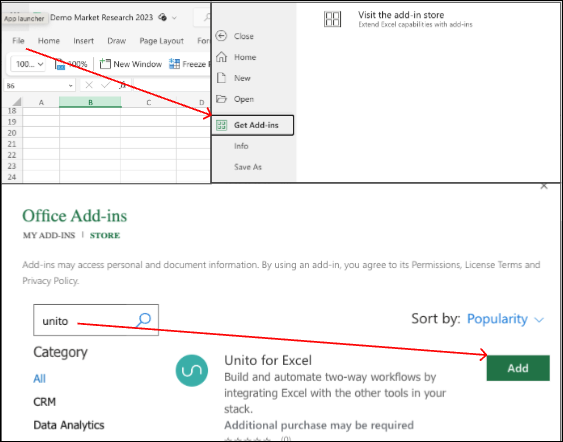
Follow the on-screen instructions to add Unito to your Microsoft workspace.
Once the add-in is installed, click Insert the two columns in this sheet.You’ll see UnitoID and Last Modified. Only columns between those two will sync with Unito. Having these columns in your table header is essential for this integration to function as intended. You can hide them, but don’t delete or modify those columns.
Step 3. Connect ClickUp and Excel to Unito
- Open the Unito App and click +Create Flow.
- Click Start Here to connect ClickUp and Excel in any order.
- Select an account for each of your tools.
- Choose the ClickUp Project and Excel spreadsheet you want to connect.

You can pull up your Excel spreadsheet by hitting Select workbook and picking the spreadsheet you want to sync.
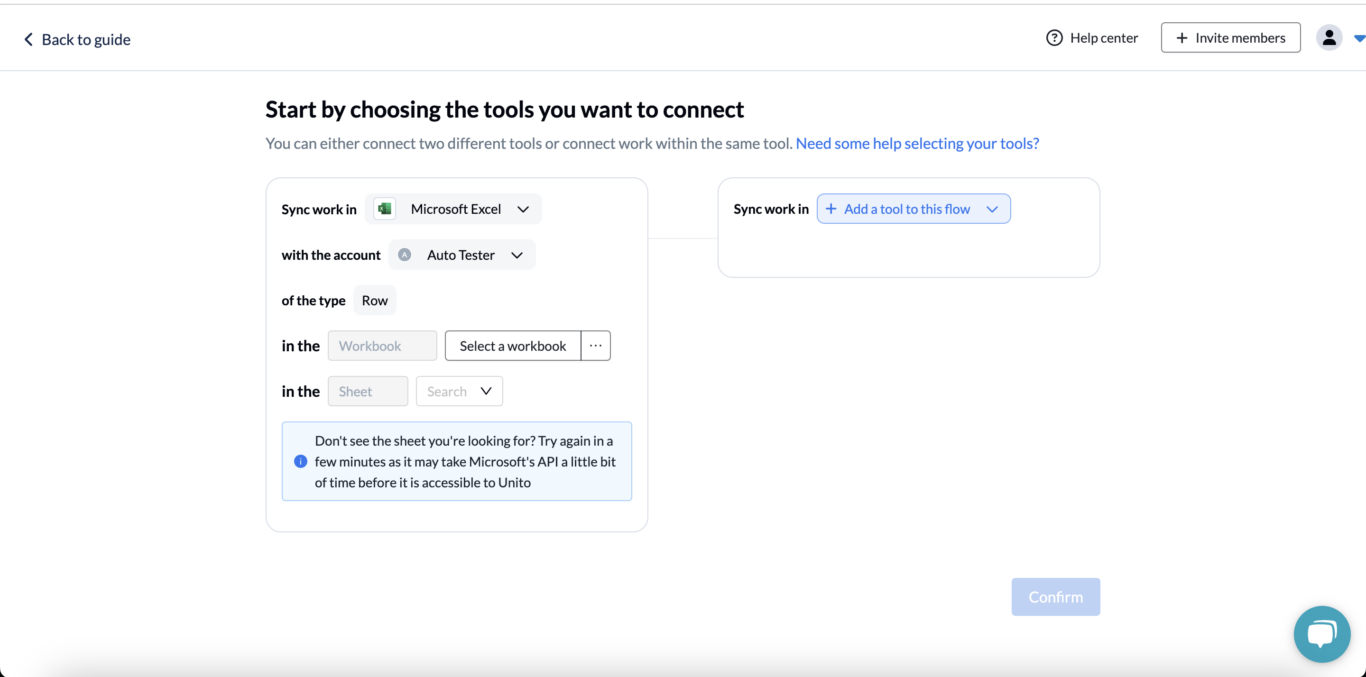
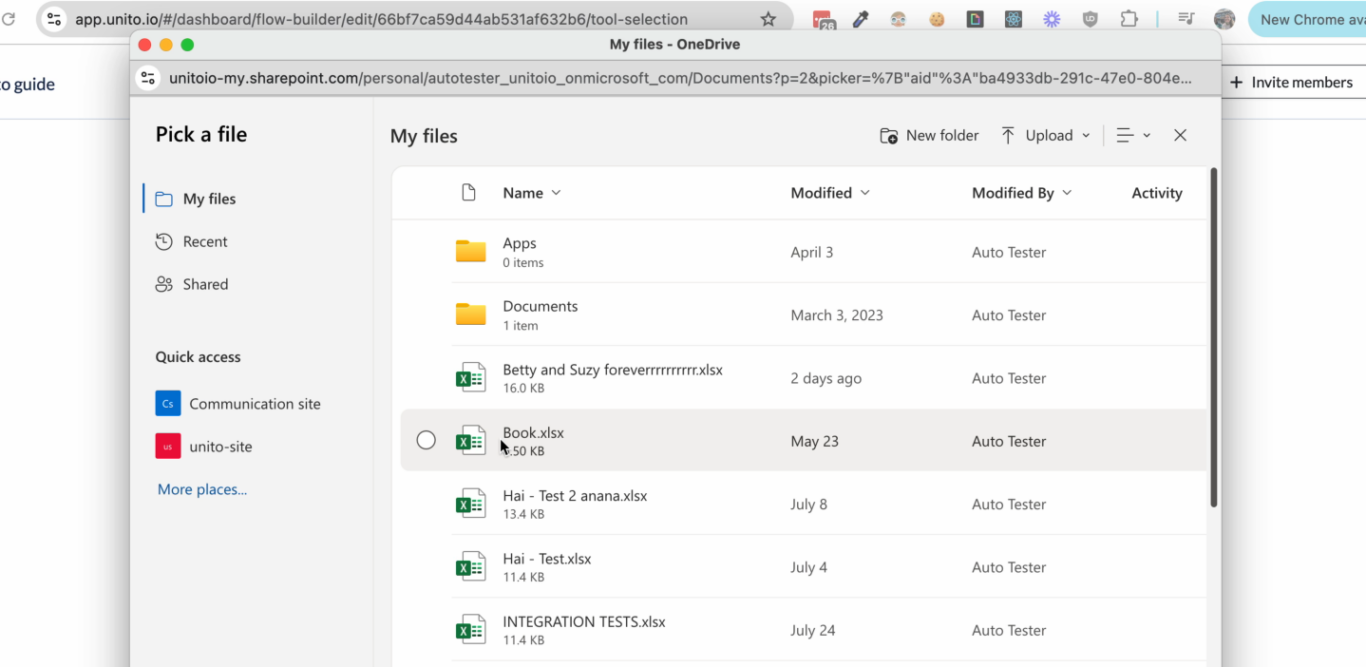
When you’re ready, click Confirm.
Step 4. Set a flow direction between ClickUp and Excel
Flow direction determines how new rows are created but not modified in your spreadsheets. We’ll determine how tasks and rows will be modified later on.

NOTE: Here’s a breakdown of each option:
- One-way from ClickUp to Excel: Tasks created in your ClickUp project will appear as new rows in Excel, but not vice versa.
- One-way from Excel to ClickUp: Rows created in Excel will appear as new ClickUp tasks, but not vice versa.
- Two-way sync: Any new sheet rows or tasks created in their respective tools will appear in the other (rows as tasks, and tasks as rows).
Click Confirm when you’ve chosen a flow direction.
Step 5. Set up rules to filter data between ClickUp and Excel
You can set rules to filter out specific ClickUp tasks from syncing to Microsoft Excel (or vice versa). This is especially valuable if your projects contain many tasks, but only some of them are relevant for your spreadsheet use case.
Now we can choose rules that tell Unito which ClickUp tasks or Excel rows to keep in sync.
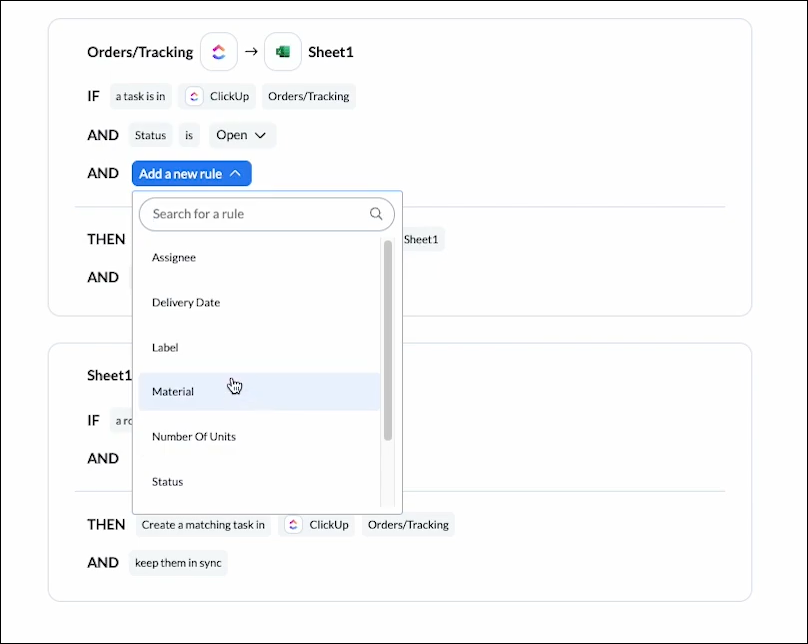
For this demo, we’ve told the system to create a matching row in Excel for every task in our ClickUp project with the tags: “Demo Tag 1” and “Demo Tag 2.” If you’re syncing tasks, you consider filtering rules by progress, opting for tag names such as: in progress, blocked, done, etc.
Find out more about setting rules.
Step 6. Pair fields between ClickUp and Excel
This step allows you to establish the relationship between your ClickUp fields and Excel columns. Basically you’re telling Unito where to populate the details of each task (e.g., assignee, description, due date, etc.).
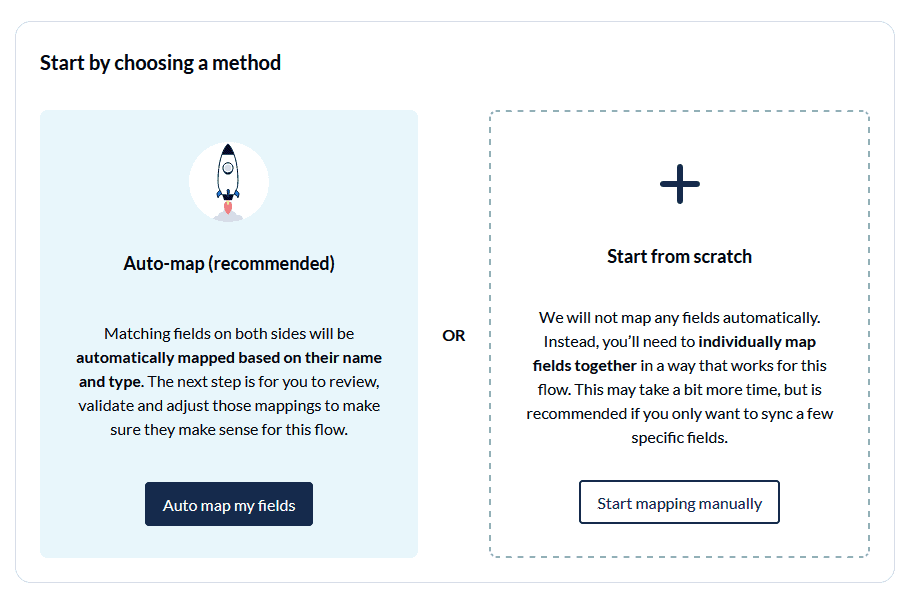
Select Start from scratch. Since every field in Excel is a custom field, Unito can’t auto-map them.
Click +Add mapping to select an ClickUp task field and a matching Excel field to keep in sync. This is where the fields you create in your table header will appear.
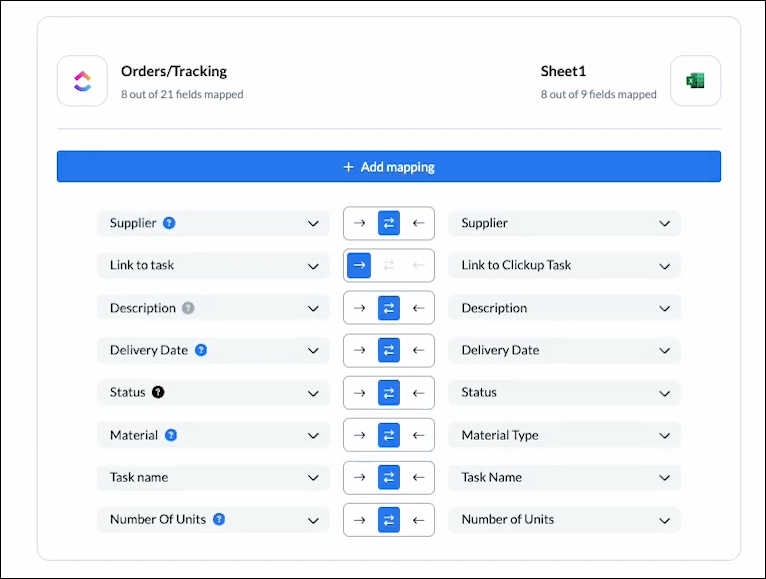
If you forgot to include a field in Excel, you can add new columns or change the names, but you’ll have to close your browser tab with Unito and re-open it for the changes to appear in your flow.
Click Confirm when you’re satisfied with your field mappings to proceed.
Find out more about setting field mappings.
Note: If you change a column name in a synced spreadsheet, be sure to update your flow’s field mappings in Unito or else your data will stop syncing.
Step 7. Save, close, and launch your ClickUp – Excel Flow!
If you’ve followed the steps above, your Unito flow will now:
- Create new rows in Excel based on specified ClickUp tasks.
- Keep those rows and tasks updated in real-time based on our field mappings.
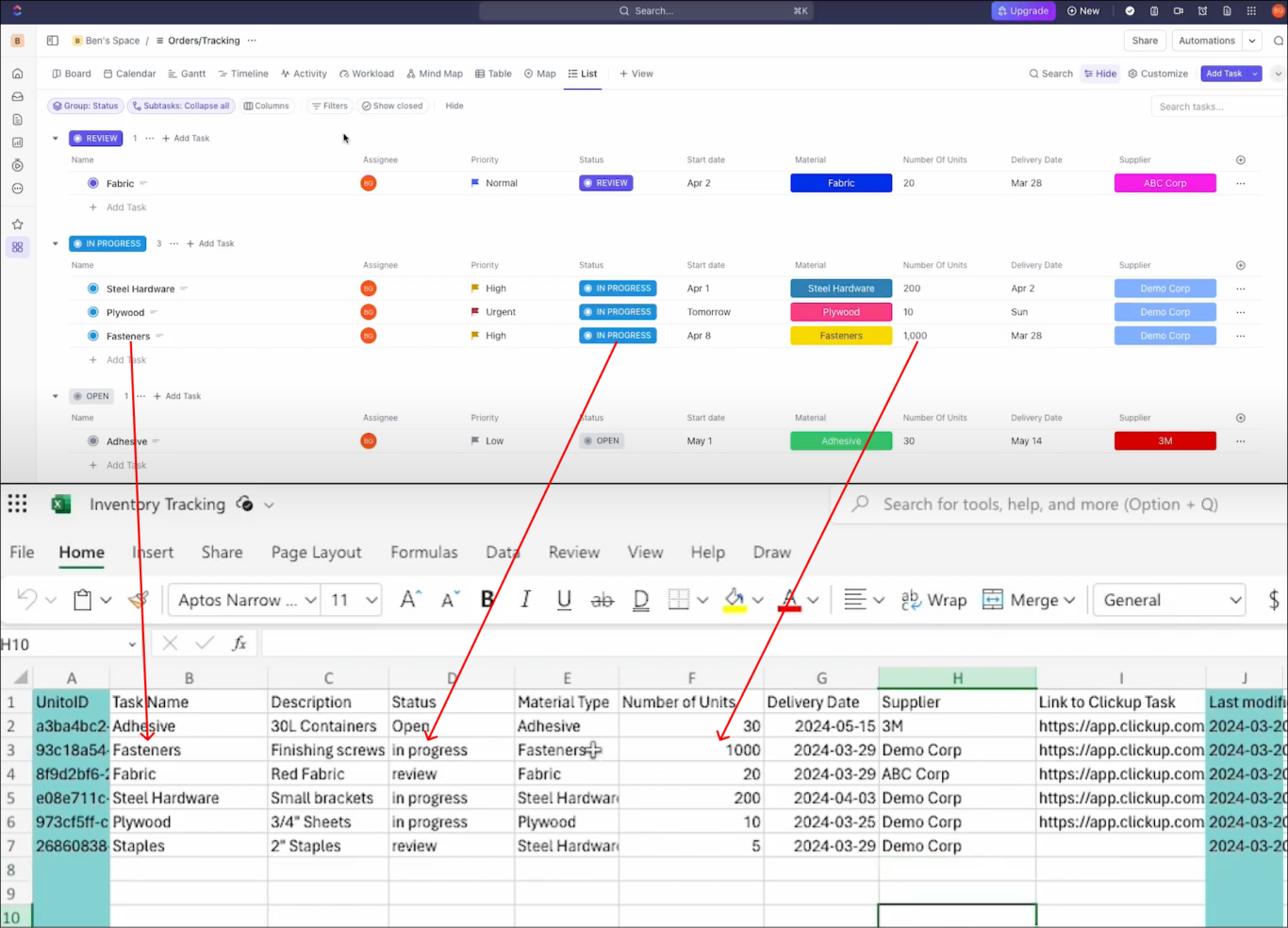
What’s next after syncing ClickUp tasks to Excel rows?
- Duplicate this flow to sync tasks from other projects to your Google Sheet.
- Read our overviews of ClickUp and Excel to better understand the capabilities and limitations of each integration.
- Sync your tasks from ClickUp to Google Calendar.
- Export ClickUp tasks to Google Sheets with Unito.
- Need help? Here’s our troubleshooting guide for Microsoft Excel
- Align with your dev team by connecting ClickUp and Jira or ClickUp to GitHub.
- Follow a similar guide to sync Trello and Excel, Microsoft Excel with Airtable, Excel and monday.com, Excel and Wrike, Excel and Google Sheets, and Jira with Excel.
- Attend a demo webinar to find out what else you can do with Unito.
Best practices and troubleshooting for Unito’s Excel integration
Common error messages
If you see either of the error messages below, it likely indicates that one or both of the columns: “UnitoID” and “Last Modified” have been deleted or modified from your sheet. You’ll need to re-insert them (either manually or with the add-on) before your data will sync again.
“We’ve detected that mandatory columns have been removed from your Google Sheet. Let’s get you back up and running.”
“The container configuration does not allow us to sync.”
Why connect ClickUp and Excel with Unito?
Syncing tasks to spreadsheet rows is especially helpful when you want to speed up the process of reviewing tasks from the uniformity and flexibility of a spreadsheet. You can build reports for stakeholders quickly and efficiently through simple automation. It’s also handy for reviewing budgets and expenses; resource management; and collaborating with external contractors, clients, or other contacts.
It’s also useful for sharing specific information about a task or project with an external contact without giving them full access to your ClickUp organization or workspace. You can even allow your external contact’s changes in Excel to be automatically reflected in your ClickUp tasks with a 2-way sync.
Getting around with Excel and Unito
You can find more information on the following topics in Unito’s knowledge base:
- Supported fields in Excel and other features
- Setting rules in Unito to manage your spreadsheets
- Creating spreadsheets with Unito
- Adjusting the date + time format in a spreadsheet
- Finding spreadsheets by their URL
Best use cases for syncing ClickUp tasks to Excel rows
Unito can export ClickUp to Excel or vice versa (keeping both in a real-time, 2-way sync) to not only save you from copy-pasting tasks manually into a spreadsheet, but also to keep your data up-to-date from end-to-end.
Integrating ClickUp and Excel simplifies the process of building progress reports, project timelines, managing human resources, analyzing financial details related to tasks and other use cases requiring you to paste ClickUp project details into Excel.
Here are just some of the benefits of integrating ClickUp with Microsoft Excel:
- Effortless Data Export: Automatically transform your ClickUp lists into structured Excel tables.
- Real-time Sync: Maintain consistency between apps with dynamic 2-way sync, ensuring data stays fresh automatically whenever you make manual changes.
- Enhanced Data Analytics: Leverage Excel’s robust formulas and tools to gain deeper insights into your ClickUp projects without having to export/import CSV files.
Sync custom fields with Unito to truly explore any use case
Custom fields are fully supported by Unito. You can even sync new custom fields from ClickUp to Excel by adding them to your flow. A flow is the connection between apps that you create in Unito.
Can ClickUp import tasks from Excel?
Yes absolutely! You can import ClickUp project data without needing a CSV file to sync new tasks or historical data automatically. The goal is to create workflows that enable you to efficiently organize your project management without replacing an old process with an equally complex one.
Optimize your process in ClickUp and Microsoft Excel
Your ability to import or export from ClickUp or Microsoft Excel will massively impact your process on how best to track teams quickly and effectively, by working the way you want from the interface of your choice.
Enjoy the comfort of a familiar project or spreadsheet
Those who prefer to stay in their projects or spreadsheets can do so, and you can track any teams progress automatically. It’s a new tool in your toolkit that will make a big difference whether you’re syncing new projects or older on-going campaigns.
Why connect ClickUp lists to an Excel spreadsheet?
No more exporting or importing CSV files
Syncing ClickUp tasks to Excel rows enables you to speed up the reporting process by populating your data table with live updates from ClickUp that change as work is completed. So when someone in ClickUp updates a task, Unito enables you to see those changes from Excel in real-time.
This method saves you the hassle of exporting or importing a CSV file. Instead you can manage data manually with a 2-way integration. Your project timeline will thank you when all of your exported data appears in Excel automatically as a synced spreadsheet.
Spend more time finessing your dashboard
You can build reports for stakeholders quickly and efficiently through simple automation that establishes a fully-synced spreadsheet. It’s handy for reviewing budgets and expenses; resource management; and collaborating with external contractors, clients, or other contacts across a variety of apps and tools.
Project management is all about efficiency and optimizing your workflow. So being able to manage multiple projects at once becomes a simpler process when you export ClickUp task field data to Excel quickly and automatically.


